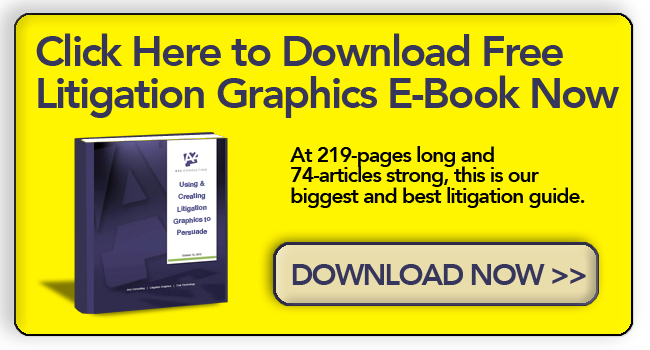by Alex Brown
Director of Operations
A2L Consulting
The definition of power is the capacity or ability to direct or influence the behavior of others or the course of events. Graphic artists of all shapes and sizes, once they fully delve into using the Microsoft PowerPoint tool, usually end up surprised by the power inherent in PowerPoint.
When you hear people say they hate PowerPoint presentations, they usually use excuses like; “It’s too wordy, excessive effects, it puts me to sleep, Group read along, Rorschach effect, frivolous fonts, and BULLET POINTS!”
The truth is they are correct. PowerPoint is not always used to create litigation graphics to the best effect. But that doesn’t mean you should blame the tool. Here are 12 tips and features of PowerPoint that will excite and enlighten even the most creative thinker.
- Narrate over slides. This is especially effective when you need to create a technology tutorial or explain otherwise complicated material. We have done this for many a client using professional narrators and always with the desired effect. The audience is engaged and understanding the message as they should.
- Pan and zoom. Images can do more than just appear on the screen. You can create movement to keep your audience focused on what you want them to focus on. This is effective when you have a lot of images that you want to share, but in the end, you want them to focus on a specific one. You can use the zoom feature to focus them and then you can add callouts so they understand what they are seeing and what you want them to remember.
- Embed a functioning Excel worksheet. Suppose that your damages expert has made some brilliant worksheets. Embed them into your deck. There’s no reason to use paper handouts or to switch from one program to another. You can also manipulate the worksheet so they focus on the numbers that are key.
- Pop-up/call out Instead of having a slide appear completely filled with text, have it appear when needed and be replaced as you move down your key points. This is effective because you allow your audience’s eyes to focus on specific things and keep them engaged. Science dictates that they will retain more information this way.
- Charts. They can be used effectively to show how things relate to each other, such as a timeline, organizational chart, flow chart, or process diagram. Lawyers often are afraid to use charts because they fear that the audience will get ahead of the message. This is true in many cases, which is why you want them to build up slowly, not just sit on the screen as a static image.

- Pictogram or infographic images. What is expected from a trial team changes almost monthly. Today, infographics are huge, and the icons, images, and feel of infographics are comfortable and accepted. Use today’s marketing messaging to your advantage so your audience receives the message and retains the information.
- Highlight text to draw attention. Use a call-out to highlight a quote or a section of a contract. You want the audience to get the feel of what is being highlighted but you also want them to remember a few impact words. We all remember the old videos with the “follow the bouncing ball.” Take advantage of that familiarity and highlight the text at the moment you want them to focus on that impact word. It can be a very powerful way to get a message across to your audience.
- Illuminate, glow, or change the color of the text to draw attention. Like highlighting, you can also be subtle and use these options to almost subconsciously get them to remember impact words during deliberation.
- Embed videos. Today, your audience expects you to show them something that will wow them. If you don’t, you run the risk of disappointing them or even making them feel as if you were simply not trying hard enough. You want to keep their attention; what better way to grab it then to add video to your deck. You no longer need to bring up a different program or use a machine to play video. On a click, you can show them exactly what you want, highlight things throughout, create pop-ups or call-outs around it. This is very powerful and something we have been doing for years. See, 16 PowerPoint Litigation Graphics You Won't Believe Are PowerPoint.
- Animations. Many people fear animations, and they should. The courtroom is not a good place for flashing, spinning, exploding transitions. Animations are incorporated, however, in all of our decks, used sometimes without detection. The best effects are the ones that draw attention to the message, not the transition.
- Create custom bullets. Bullet points kill your presentation, period. But we still use lists, just in a way that does not make it LOOK like a bullet list. Create icons instead of black or colored dots. Don’t use them at the beginning, but add check marks at the end. This changes the feel and increases impact.
- Use 3D effects. This goes right back to what the audience expects. If you need to use a 3D image, use it. We have done this for impact and retention for years. You do not need to always use a 3D program to do it. We have used movement to backgrounds to simulate depth and perspective. All in PowerPoint. See, 16 PowerPoint Litigation Graphics You Won't Believe Are PowerPoint.
It is not your job to learn different litigation graphics packages to entertain your audience. It is your job to keep your audience engaged by employing these and hundreds of other persuasion tools so they learn and retain the information needed to achieve success when the verdict is handed down.
Other articles and resources related to the use of PowerPoint at trial, litigation graphics and PowerPoint trial graphics generally:
- The 12 Worst PowerPoint Mistakes Litigators Make
- Lawyer Delivers Excellent PowerPoint Presentation
- 7 Ways to Avoid Making Your PowerPoint Slides Your Handout
- 12 Ways to Eliminate "But I Need Everything On That PowerPoint Slide"
- 16 PowerPoint Litigation Graphics You Won't Believe Are PowerPoint
- The Redundancy Effect, PowerPoint and Legal Graphics
- The Effective Use of PowerPoint Presentation During Opening Statement
- Don't Use PowerPoint as a Crutch in Trial or Anywhere
- How Much Text on a PowerPoint Slide is Too Much?
- Do Professionally Designed PowerPoint Slides Get Better Results?
- Why Reading Your Litigation PowerPoint Slides Hurts Jurors






Leave a Comment